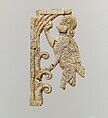Openwork plaque with a sphinx at a tree
Not on view
This fragmentary openwork plaque depicts a sphinx, a fantastic creature with a human head and the body of a winged lion. The sphinx stands on its hind legs and reaches out both paws to touch the branches of a tree, represented by a curving bunch of leafy fronds above three stylized leaves ending in a curl. These stylized leaves, called volutes, appear frequently on other carved ivory pieces from the Assyrian capital at Nimrud. Carved ivory pieces such as this were widely used in the production of elite furniture during the early first millennium B.C. They were often inlaid into a wooden frame using joinery techniques and glue, and could be overlaid with gold foil or inlaid with colored glass or stone pieces to create a dazzling effect of gleaming surfaces and bright colors. This piece has a plain border strip still visible at the top, bottom and left side, and may have been set in a wooden frame as a piece of furniture. The left edge runs through the tree, suggesting that the original composition may have been symmetrical, with an identical sphinx facing this one to the left, paired with the left half of the stylized tree. While the openwork technique is commonly associated with Phoenician ivories, the sphinx’s highly stylized hair and wings, as well as the outlines of the body, are all rendered by shallow incisions, a technique characteristic of North Syrian art.
The plaque was found in a recess behind a stone stele inscribed by Ashurnasirpal II, the Assyrian king, which describes a banquet for nearly 60,000 people he held to celebrate the partial completion of the construction of his new palace at Nimrud, the Northwest Palace.
Built by the Assyrian king Ashurnasirpal II, the palaces and storerooms of Nimrud housed thousands of pieces of carved ivory. Most of the ivories served as furniture inlays or small precious objects such as boxes. While some of them were carved in the same style as the large Assyrian reliefs lining the walls of the Northwest Palace, the majority of the ivories display images and styles related to the arts of North Syria and the Phoenician city-states. Phoenician style ivories are distinguished by their use of imagery related to Egyptian art, such as sphinxes and figures wearing pharaonic crowns, and the use of elaborate carving techniques such as openwork and colored glass inlay. North Syrian style ivories tend to depict stockier figures in more dynamic compositions, carved as solid plaques with fewer added decorative elements. However, some pieces do not fit easily into any of these three styles. Most of the ivories were probably collected by the Assyrian kings as tribute from vassal states, and as booty from conquered enemies, while some may have been manufactured in workshops at Nimrud. The ivory tusks that provided the raw material for these objects were almost certainly from African elephants, imported from lands south of Egypt, although elephants did inhabit several river valleys in Syria until they were hunted to extinction by the end of the eighth century B.C.
Due to rights restrictions, this image cannot be enlarged, viewed at full screen, or downloaded.

